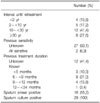Abstract
Background
Recurrent pulmonary tuberculosis (TB) can be due to relapse of the original infecting strain or due to reinfection with a new strain of Mycobacterium tuberculosis. We investigated the clinical characteristics and efficacy of short-term treatment (6 months) in patients with recurrent pulmonary TB.
Methods
Twenty-nine patients with recurrent pulmonary TB were compared with control patients who received primary treatment for pulmonary TB with respect to drug sensitivity and outcomes of treatment.
Results
Most patients with recurrent pulmonary TB (25 cases, 86.2%) recurred more than 2 years after the completion of previous treatment. Twenty-three patients (82.1%) with recurrent pulmonary TB were sensitive to all anti-tuberculous drugs and a ratio was similar to the drug sensitivities observed in control patients. The outcomes of short-term treatment in patients with drug-sensitive TB were not significantly different between the two groups.
Figures and Tables
References
1. Blumberg HM, Burman WJ, Chaisson RE, Daley CL, Etkind SC, Friedman LN, et al. American Thoracic Society/Centers for Disease Control and Prevention/Infectious Diseases Society of America: treatment of tuberculosis. Am J Respir Crit Care Med. 2003. 167:603–662.
2. Jasmer RM, Bozeman L, Schwartzman K, Cave MD, Saukkonen JJ, Metchock B, et al. Recurrent tuberculosis in the United States and Canada: relapse or reinfection? Am J Respir Crit Care Med. 2004. 170:1360–1366.
3. Verver S, Warren RM, Beyers N, Richardson M, van der Spuy GD, Borgdorff MW, et al. Rate of reinfection tuberculosis after successful treatment is higher than rate of new tuberculosis. Am J Respir Crit Care Med. 2005. 171:1430–1435.
4. The Korean Academy of Tuberculosis and Respiratory Diseases. Guideline for pneumonia and tuberculosis. 2005. Seoul: The Korean Academy of Tuberculosis and Respiratory Diseases.
5. Hong Kong Chest Service/British Medical Research Council. Five-year follow-up of a controlled trial of five 6-month regimens of chemotherapy for pulmonary tuberculosis. Am Rev Respir Dis. 1987. 136:1339–1342.
6. Hong Kong Chest Service/British Medical Research Council. Controlled trial of 2, 4, and 6 months of pyrazinamide in 6-month, three-times-weekly regimens for smear-positive pulmonary tuberculosis, including an assessment of a combined preparation of isoniazid, rifampin, and pyrazinamide. Results at 30 months. Am Rev Respir Dis. 1991. 143:700–706.
7. Combs DL, O'Brien RJ, Geiter LJ. USPHS Tuberculosis Short-Course Chemotherapy Trial 21: effectiveness, toxicity, and acceptability. The report of final results. Ann Intern Med. 1990. 112:397–406.
8. Bandera A, Gori A, Catozzi L, Degli Esposti A, Marchetti G, Molteni C, et al. Molecular epidemiology study of exogenous reinfection in an area with a low incidence of tuberculosis. J Clin Microbiol. 2001. 39:2213–2218.
9. de Boer AS, van Soolingen D. Recurrent tuberculosis due to exogenous reinfection. N Engl J Med. 2000. 342:1050–1051.
10. Garcia de Viedma D, Marin M, Hernangomez S, Diaz M, Ruiz Serrano MJ, Alcala L, et al. Tuberculosis recurrences: reinfection plays a role in a population whose clinical/epidemiological characteristics do not favor reinfection. Arch Intern Med. 2002. 162:1873–1879.
11. van Rie A, Warren R, Richardson M, Victor TC, Gie RP, Enarson DA, et al. Exogenous reinfection as a cause of recurrent tuberculosis after curative treatment. N Engl J Med. 1999. 341:1174–1179.
12. Fitzpatrick LK, Okwera A, Mugerwa R, Ridzon R, Ehiner J, Onorato I. An investigation of suspected exogenous reinfection in tuberculosis patients in Kampala, Uganda. Int J Tuberc Lung Dis. 2002. 6:550–552.
13. Krüüner A, Pehme L, Ghebremichael S, Koivula T, Hoffner SE, Mikelsaar M. Use of molecular techniques to distinguish between treatment failure and exogenous reinfection with Mycobacterium tuberculosis. Clin Infect Dis. 2002. 35:146–155.
14. Sonnenberg P, Murray J, Glynn JR, Shearer S, Kambashi B, Godfrey-Faussett P. HIV-1 and recurrence, relapse, and reinfection of tuberculosis after cure: a cohort study in South African mineworkers. Lancet. 2001. 358:1687–1693.
15. van Embden JD, Cave MD, Crawford JT, Dale JW, Eisenach KD, Gicquel B, et al. Strain identification of Mycobacterium tuberculosis by DNA fingerprinting: recommendations for a standardized methodology. J Clin Microbiol. 1993. 31:406–409.
16. Tam CM, Chan SL, Kam KM, Goodall RL, Mitchison DA. Rifapentine and isoniazid in the continuation phase of a 6-month regimen. Final report at 5 years: prognostic value of various measures. Int J Tuberc Lung Dis. 2002. 6:3–10.
17. Aber VR, Nunn AJ. Short term chemotherapy of tuberculosis. Factors affecting relapse following short-term chemotherapy. Bull Int Union Tuberc. 1978. 53:276–280.
18. Benator D, Bhattacharya M, Bozeman L, Burman W, Cantazaro A, Chaisson R, et al. Rifapentine and isoniazid once a week versus rifampicin and isoniazid twice a week for treatment of drug-susceptible pulmonary tuberculosis in HIV-negative patients: a randomised clinical trial. Lancet. 2002. 360:528–534.
19. Mitchison DA. Assessment of new sterilizing drugs for treating pulmonary tuberculosis by culture at 2 months. Am Rev Respir Dis. 1993. 147:1062–1063.
20. Zierski M, Bek E, Long MW, Snider DE Jr. Short-course (6-month) cooperative tuberculosis study in Poland: results 30 months after completion of treatment. Am Rev Respir Dis. 1981. 124:249–251.
21. Chang KC, Leung CC, Yew WW, Ho SC, Tam CM. A nested case-control study on treatment-related risk factors for early relapse of tuberculosis. Am J Respir Crit Care Med. 2004. 170:1124–1130.




 PDF
PDF ePub
ePub Citation
Citation Print
Print






 XML Download
XML Download